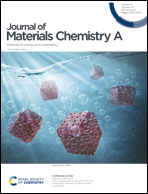Plasmon-induced catalytic CO2 hydrogenation by a nano-sheet Pt/HxMoO3−y hybrid with abundant surface oxygen vacancies†
Abstract
Taking full advantage of solar light to promote CO2 hydrogenation remains a challenge in the catalysis field. Combining a degeneratively-doped metal oxide and a precious metal to obtain hybrids with plasmonic absorption in the visible-light region enables the high-efficiency utilization of solar light in photothermal catalysis. Herein, MoO3 samples with different morphologies were synthesized and combined with Pt to form hybrid materials with a strong plasmonic effect. Among the Pt/MoO3 hybrids with various morphologies, the Pt/HxMoO3−y(Sheet) hybrid displayed the best performance in the photothermal synergistic catalysis of the reverse water-gas shift (RWGS) reaction at 140 °C under visible light irradiation because of the advantages of its nanosheet structure (e.g., a high specific surface area, high proportion of exposed surface atoms, and good optical transparency). The Pt/HxMoO3−y(Sheet) catalyst outperformed Pt/HxMoO3−y hybrids with a bulk, belt, or rod morphology. Thermogravimetry, UV-vis-NIR diffuse reflectance spectroscopy, and model reactions demonstrated that the Pt/HxMoO3−y(Sheet) hybrid contained the largest amount of surface O vacancies and exhibited the strongest plasmonic absorption, which are the primary reasons for its highest catalytic activity among the investigated hybrid catalysts. Photoelectric characterization revealed that the Pt/HxMoO3−y(Sheet) hybrid could generate hot electrons under visible-light irradiation. X-ray photoelectron spectroscopy measurements showed a reversible redox event of the Mo atoms, demonstrating that the O vacancies in Pt/HxMoO3−y(Sheet) acted as active sites and regenerated during the reaction. A possible mechanism is proposed for the photothermal synergistic catalysis in the RWGS reaction. The nanosheet-structured Pt/HxMoO3−y hybrid can exploit solar energy to greatly reduce energy consumption during the CO2 hydrogenation reaction, providing a greener and energy-saving scheme for the conversion of CO2 to CO.



 Please wait while we load your content...
Please wait while we load your content...